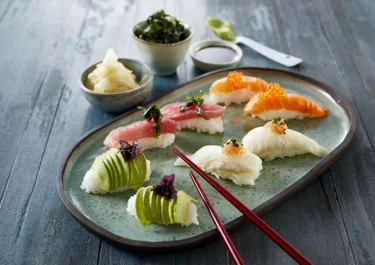Nigiri sushi

Discover the refined world of Japanese cuisine with our nigiri sushi recipe. Tasty fish meets perfectly seasoned rice with this variety of nigiri. Enjoy the smooth taste of salmon, the deep flavour of tuna, the understated elegance of turbot, and the lush texture of avocado mixed with spicy wasabi as well as salty roe and nori seaweed.
Ingredients
Sushi rice
|
Sushi rice
|
450 g |
|---|---|
|
Water
|
450 ml |
|
Sugar
|
50 ml |
|
Coarse salt
|
2 tsp |
|
Japanese rice vinegar
|
75 ml |
|
Wasabi
|
2½ tbsp |
With salmon
|
Fresh salmon (sushi quality − frozen minimum 24 hours and thawed)
|
125 g |
|---|---|
|
Salmon roe
|
100 ml |
With tuna
|
Tuna (sushi quality − frozen minimum 24 hours and thawed)
|
125 g |
|---|---|
|
Nori seaweed
|
With turbot
|
Turbot (sushi quality − frozen minimum 24 hours and thawed)
|
125 g |
|---|---|
|
Lumpfish roe
|
3 tbsp |
With avocado
|
Avocados, very thinly slices
|
2 |
|---|---|
|
Red nori seaweed
|
To serve
|
Japanese soya sauce
|
100 ml |
|---|---|
|
Pickled ginger
|
75 g |
|
Wasabi
|
Instructions
Sushi Rice
Nigiri Sushi
With salmon
With tuna
With turbot
With avocado
FAQ: Questions about nigiri sushi
Whether you are well-versed in sushi or just starting, our questions and answers below should help improve your knowledge of nigiri sushi!
What is nigiri sushi?
Nigiri sushi is a popular type of sushi that consists of a small ball of hand-pressed sushi rice, typically seasoned with vinegar and topped with a slice of raw or cooked seafood. The topping can include a variety of raw fish such as tuna, salmon, or yellowtail, as well as other seafood like shrimp, eel, or octopus. Sometimes, the topping is secured to the rice with a thin strip of nori (seaweed). It is often served with soy sauce, wasabi, and pickled ginger.
What are some common types of nigiri?
Nigiri sushi is cherished for its variety. Favourites include salmon, with its rich flavour, and tuna, known for its firm texture. Turbot offers a delicate taste, while avocado adds creaminess. Other common toppings are mackerel, halibut, scallops, squid, and eel, each bringing their characteristic flavours and textures. Tofu and various types of roe add different textures, while tamago, a sweet, folded omelette, provides a delightful contrast. These diverse options make nigiri an exciting and versatile choice for sushi lovers.
Do I have to freeze fish before making nigiri sushi?
Yes, you should freeze fish before making nigiri sushi at home. It is important to freeze raw fish for at least 24 hours to kill any parasites, making it safe to eat raw. However, if you buy sushi-grade fish, it is already treated to be safe for raw consumption. Always confirm with the seller that the fish has been properly treated and is safe to eat raw. The raw fish should look bright, feel firm, and smell fresh, whether you buy sushi-grade raw fish or freeze fish at home to make it safe.
Tips: Making the best homemade nigiri sushi
Take your homemade nigiri sushi to new heights with our useful tips. Learn how to make each piece flawless and get ready to wow with every bite.
Select sushi-grade fish
When making sushi, it is important to use fresh and high-quality fish. The raw fish should have vibrant colours, a firm texture, and a fresh ocean scent. These signs indicate it is fresh and suitable for raw dishes, affecting both taste and safety.
The right sushi rice texture
The right sushi rice texture is slightly sticky but not mushy, with each grain tender yet firm. It should hold together well for shaping but maintain individual grain structure. Properly cooked sushi rice has a glossy, shiny appearance, indicating it has been correctly seasoned with a balanced mix of rice vinegar, sugar, and salt.
Rinse the rice four to five times until the water is clear to remove excess starch. Soak the rice in cold water for 30 minutes to help the grains absorb flavours, then drain and cook with the right amount of water on low heat to protect the texture. After the water is absorbed, let the rice sit covered for 10–15 minutes to steam and become fluffy. While warm, mix in rice vinegar, sugar, and salt until dissolved. Spread the rice to cool to room temperature before shaping.
Slicing the fish
Slicing fish for nigiri requires precision and the right technique. Start with a very sharp chef's or sushi knife to ensure clean cuts. Place the fish on a cutting board and hold it firmly. Slice at a 45-degree angle, cutting across the grain. Use a single, smooth motion to avoid tearing the flesh. The slices should be about ½ cm thick and long enough to cover the rice. Keep the knife clean and wet it occasionally to prevent sticking.
Hand-forming nigiri
To shape traditional nigiri, wet your hands with water or water and vinegar mixture to prevent sticking. Take a bit of seasoned sushi rice, about 20–25 grams, and gently form it into an oval shape using your fingers. It should be about 5 cm long. The rice should be firm enough to hold its shape but not too dense.
Place the shaped rice in your left hand and lay the fish or topping on top. Use your right hand to gently press the fish onto the rice, ensuring it adheres well. Press the sides of the rice lightly with your fingers to create a neat, compact shape. Maintain some air pockets within the rice to keep it light. You can secure the topping with a thin strip of nori, especially for toppings like eel or tamago. If you want to use wasabi in your nigiri to enhance the flavour with a spicy kick, place a small amount between the rice and the topping.
Enjoy a taste of Japan with our homemade nigiri sushi
Indulge in our delicious, homemade nigiri sushi. Each piece combines the perfect texture of seasoned sushi rice with fresh, flavourful toppings. The slightly sticky vinegared rice serves as a delicate base, enhancing the taste of each topping. Whether you prefer the rich, buttery texture of salmon, the robust flavour of tuna, the subtle sweetness of turbot, or the creamy smoothness of avocado, this recipe promises a taste of Japan with every bite.
Salmon nigiri
Salmon nigiri is a classic favourite, offering a rich, buttery flavour. This goes perfectly with the slightly tangy and sweet sushi rice. The fresh salmon melts in your mouth, and the salmon roe on top adds a burst of briny goodness with each bite.
Tuna nigiri
Tuna nigiri is a staple in Japanese cuisine, known for its deep, distinct flavour and firm texture. The addition of nori seaweed garnish adds a subtle umami flavour, a delicious contrast to the tuna.
Turbot nigiri
Turbot nigiri offers a mild, slightly sweet flavour and tender texture. The thinly sliced turbot sits elegantly atop the seasoned rice, creating a light and refined bite. Garnished with lumpfish roe, each piece gets a pop of briny richness to complement the subtle taste of the turbot.
Avocado nigiri
Avocado nigiri is simple and delicious, balancing the creamy, smooth texture of ripe avocado with the slightly tangy sushi rice. The thinly sliced avocado provides a rich, buttery flavour, and garnished with red nori seaweed, it gets a delicious hint of umami.
Serve a classic sushi dinner
Bring the authentic flavours of Japan right to your table with our delicious nigiri sushi recipe. Arrange the nigiri pieces artfully on a platter, garnishing each piece with either roe or seaweed to make them both tasty and decorative. Accompany your sushi with traditional sides like pickled ginger, which serves as a palate cleanser, and a small dish of high-quality Japanese soy sauce for dipping.
You can also consider your serving setting. Presenting the sushi on a bamboo sushi mat or a simple plate with your sides in small bowls for an elegant serving.
Serve your nigiri with different types of maki sushi, or explore more recipes with fish and seafood with our prawn pasta recipe or jambalaya with blue mussels and crayfish tails.
Make it your own
Get creative and try new flavour combinations to make your homemade sushi adventure even more interesting. Beyond our recipe's versions with salmon, tuna, turbot, and avocado, you can explore different fish options like eel, halibut, mackerel, or yellowtail. Try flambéing salmon or tuna for a smoky, charred flavour.
Decorate and garnish your nigiri with toppings like toasted sesame seeds for a nutty flavour and crunch, chopped green onions for a fresh, mildly spicy note, or micro greens for a burst of freshness. Thinly sliced lemon or lime can offer a zesty contrast, while roe, tobiko or masago add vibrant colour, texture, and a salty flavour.
For garnish with more pungent flavours, a small piece of pickled ginger or other pickled vegetables on top adds a burst of acidity, and a tiny dab of garlic paste or roasted garlic adds depth, with roasted garlic offering a sweet, nutty taste.
You can also explore different soy sauces. Use light soy sauce for white fish to preserve its subtle taste. A dark soy sauce is ideal for bolder flavours like tuna, salmon, or mackerel; for example, tamari soy sauce, which is richer and thicker and enhances the bolder fish's natural taste with its robust, savoury quality.








